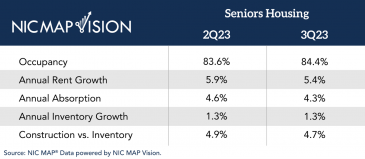NIC Report: Senior Housing Occupancy Rate Increases for Ninth Consecutive Quarter
October 11, 2023
ANNAPOLIS, MD — The senior housing occupancy rate for the 31 NIC MAP Primary Markets increased nearly a full percentage point, from 83.6 percent in the second quarter of 2023 to 84.4 percent in the third quarter, according to data from NIC MAP Vision released by the National Investment Center for Seniors Housing & Care (NIC). While the occupancy rate has increased 6.6 percentage points overall from a pandemic low of 77.8 percent in the second quarter of 2021, it is still more than 2.5 percentage points below the pre-pandemic level of 87.1 percent in the first quarter of 2020.
 According to the report, this marks the ninth consecutive quarter of occupancy recovery, driven by record-high rates of demand. Third quarter net absorption was nearly three times new supply, and the total number of occupied residences continued to climb to record levels.
According to the report, this marks the ninth consecutive quarter of occupancy recovery, driven by record-high rates of demand. Third quarter net absorption was nearly three times new supply, and the total number of occupied residences continued to climb to record levels.
“Several consecutive quarters of especially strong demand suggest that the need for the care and housing provided by senior housing is recognized,” said Chuck Harry, NIC’s chief operating officer. “If demand and supply trends continue at their current pace, senior housing occupancy will recover during 2024.”
Demand outpaced supply in both assisted-living and independent-living properties but assisted-living properties continued to recover faster than independent living. The assisted-living occupancy rate within the NIC MAP Primary Markets improved 0.9 percentage points from the prior quarter to 82.6 percent, while the independent-living occupancy rate improved 0.7 percentage points to 86.1 percent.
Occupancy within assisted-living properties from NIC MAP Secondary Markets has already fully recovered, with the rate now 0.1 percentage points above the pre-pandemic level of 84.2 percent.
Tight financing continues to influence senior housing inventory growth and new construction, according to the NIC report. Inventory grew by 0.4 percent (2,806 units) from the prior quarter. However, year-over-year inventory growth was just 1.3 percent, which is close to its smallest year-over-year increase since 2012. The number of senior housing units under construction relative to the total existing senior housing inventory was 4.7 percent, the lowest since 2014 and a 3.0 percentage decrease from the time series high of 7.7 percent recorded in the fourth quarter of 2019.
ALSO: Gray Named Director of Volunteer Engagement at NIC
Despite the strong demand, there are still 109,358 unoccupied units in the NIC MAP Primary Markets and 32,722 units under construction.
“The story of the past several quarters has been strong demand and slow inventory growth, but a significant number of units remains unoccupied,” said Caroline Clapp, NIC’s senior principal. “Senior housing and care operators are well-positioned to meet the needs of older adults who increasingly need these services.”
Boston (89.8 percent), Baltimore (88.0 percent), and Tampa (87.0 percent) had the highest occupancy rates of the 31 NIC MAP Primary Markets, while Houston (79.4 percent), Las Vegas (79.7 percent), and Atlanta (81.0 percent) recorded the lowest.
NIC, a 501(c)(3) organization, works to enable access and choice by providing data, analytics, and connections that bring together investors and providers. The organization delivers objective, and timely insights and implications derived from its analytics, which benefit from NIC’s affiliation with NIC MAP Vision, a provider of market data for senior housing and skilled nursing properties.